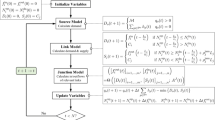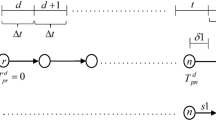Abstract
This paper studies the dynamic user optimal (DUO) traffic assignment problem considering simultaneous route and departure time choice. The DUO problem is formulated as a discrete variational inequality (DVI), with an embeded LWR-consistent mesoscopic dynamic network loading (DNL) model to encapsulate traffic dynamics. The presented DNL model is capable of capturing realistic traffic phenomena such as queue spillback. Various VI solution algorithms, particularly those based on feasible directions and a line search, are applied to solve the formulated DUO problem. Two examples are constructed to check equilibrium solutions obtained from numerical algorithms, to compare the performance of the algorithms, and to study the impacts of traffic interacts across multiple links on equilibrium solutions.
Similar content being viewed by others
References
Arnott R, de Palma A, Lindsey R (1990) Departure time and route choice for routes in parallel. Transp Res 24B:209–228
Beckmann M, McGuire CB, Winsten CB (1956) Studies in the economics of transportation. Yale University Press, New Haven, CT
Chabini I (1998) Discrete dynamic shortest path problems in transportation applications. Transp Res Rec 1645:170–175
Chen H-K, Hsueh C-F (1998) A model and an algorithm for the dynamic user-optimal route choice problem. Transp Res 32B:219–234
Chen A, Lo H, Yang H (2001) A self-adaptive projection and contraction algorithm for the traffic assignment problem with path-specific costs. Eur J Oper Res 135:27–41
Daganzo CF (1994) The cell transmission model: a dynamic representation of highway traffic consistent with the hydrodynamic theory. Transp Res 28B:269–287
Daganzo CF (1995) The cell transmission model, Part II: network traffic. Transp Res 29B:79–93
Daganzo CF (1998) Queue spillovers in transportation networks with a route choice. Transp Sci 32:3–11
Facchinei F, Pang J-S (2003) Finite-dimensional variational inequalities and complementarity problems, vol. I, II. Springer, New York
Friesz TL, Mookherjee R (2006) Solving the dynamic network user equilibrium problem with state-dependent time shifts. Transp Res 40B:207–229
Friesz TL, Bernstein D, Smith TE, Tobin RL, Wei BW (1993) A variational inequality formulation of the dynamic network equilibrium problem. Operation Research 41:179–191
Friesz TL, Bernstein D, Suo Z, Tobin RL (2001) Dynamic network user equilibrium with state-dependent time lags. Networks and Spatial Economics 1:319–349
Han D, Lo H (2002) New alternating direction method for a class of nonlinear variational inequality problems. J Optim Theory Appl 112:549–560
He B (1997) A class of projection and contraction methods for monotone variational inequality. Appl Math Optim 35:69–76
Huang HJ, Lam WHK (2002) Modeling and solving dynamic user equilibrium route and departure time choice problem in network with queues. Transp Res 36B:253–273
Jin WL, Zhang HM (2003) On the distribution schemes for determining flows through a merge. Transp Res 37B:521–540
Kuwahara M (1990) Equilibrium queuing patterns at a two-tandem bottleneck during the morning peak. Transp Sci 24:217–229
Lighthill MJ, Whitham JB (1955) On kinematic waves: I. Flow modeling in long rivers, II. A theory of traffic flow on long crowded roads. In Proceedings of the Roy Society A 229:291–345
Lo HP, Szeto WY (2002) A cell-based variational inequality formulation of the dynamic user optimal assignment problem. Transp Res 36B:421–443
Mahmassani H, Herman R (1984) Dynamic user equilibrium departure time and route choice on idealized traffic arterials. Transp Sci 18:362–384
Nagurney A (1993) Network economics: A variational inequality approach. Kluwer, Norwell, MA, USA
Newell G (1987) The morning commute for non-identical travelers. Transp Sci 21:74–88
Nguyen S, Dupius C (1984) An efficient method for computing traffic equilibria in networks with asymmetric transportation costs. Transp Sci 18:185–202
Nie Y (2006) A variational inequality approach for inferring dynamic origin-destination travel demands. PhD dissertation, University of California, Davis. http://www.civil.northwestern.edu/people/nie-diss.pdf
Nie Y, Zhang HM (2005) Equilibrium analysis of the morning commute problem: numerical solution procedures. Journal of Mathematical and Computer Modeling, under review
Ran B, Hall RW, Boyce D (1996) A link-based variational inequality model for dynamic departure time/route choice. Transp Res 30B:31–46
Richards PI (1956) Shockwaves on the highway. Operation Research 4:42–51
Sheffi Y (1985) Urban transportation networks. Prentice-Hall, New Jersey
Small KA (1982) The scheduling of consumer activities: work trips. Am Econ Rev 72:467–479
Smith MJ (1993) A new dynamic traffic model and the existence and calculation of dynamic user equilibria on congested capacity-constrained road networks. Transp Res 26B:49–63
Szeto WY, Lo HP (2004) A cell-based simultaneous route and departure time choice model with elastic demand. Transp Res 38B:593–612
Tong CO, Wong SC (2000) A predictive dynamic traffic assignment model in congested capacity-constrained road networks. Transp Res 34B:625–644
Vickrey W (1969) Congestion theory and transport investment. Am Econ Rev 59:251–261
Wardrop JG (1952) Some theoretical aspects of road traffic research. In Proceedings of the Institute of Civil Engineers, Part II 1:325–378
Wei BW, Tobin RL, Friesz TL, Bernstein D (1995) A discrete time, nested cost operator approach to the dynamic network user equilibrium problem. Transp Sci 29:79–92
Wei BW, Tobin RL, Carey M (2002) The existence, uniqueness and computation of an arc-based dynamic network user equilibrium formulation. Transp Res 36B:897–918
Yang H, Huang H-J (1997) Analysis of the time-varying pricing of a bottleneck with elastic demand using optimal control theory. Transp Res 31B:425–440
Zhang HM, Nie Y (2005) Modeling network flow with and without link interaction: properties and implications. Paper presented at the 84th annual meeting of the Transportation Research Board
Zhu DL, P Marcotte (1993) Modified descent direction methods for solving the monotone variational inequality problem. Oper Res Lett 14:111–120
Author information
Authors and Affiliations
Corresponding author
Rights and permissions
About this article
Cite this article
Nie, Y.(., Zhang, H.M. Solving the Dynamic User Optimal Assignment Problem Considering Queue Spillback. Netw Spat Econ 10, 49–71 (2010). https://doi.org/10.1007/s11067-007-9022-y
Published:
Issue Date:
DOI: https://doi.org/10.1007/s11067-007-9022-y




